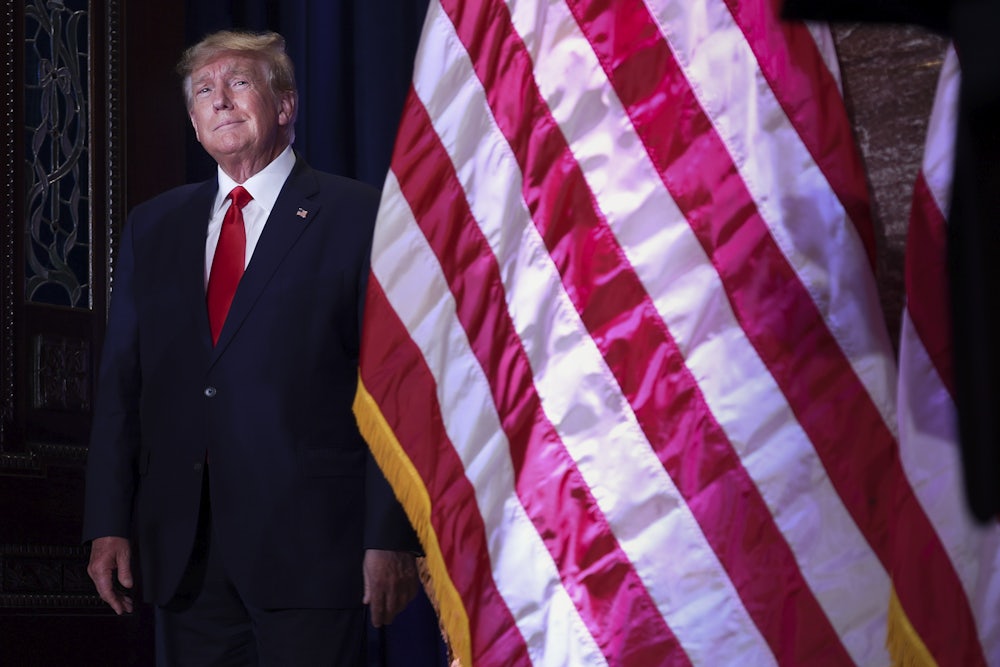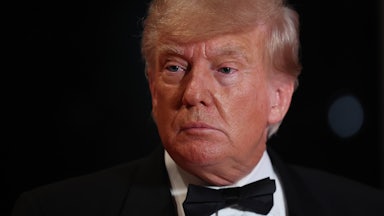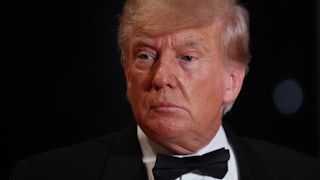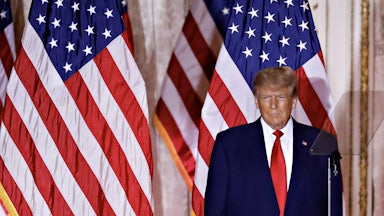Last Saturday, Donald Trump stood before a crowd and said a bunch of Donald Trumpy things. Flanked by South Carolina’s senior senator, Lindsey Graham, and its governor, Henry McMaster, Trump railed against RINOs, transgender rights, electric cars, Florida Governor Ron DeSantis (he is still trying to make “Ron DeSanctimonious” happen), President Joe Biden, Hunter Biden, and the cancellation of gas stoves. It was not a rally—it was his second small event of the day, the first being an address to New Hampshire’s Republican Party. Nevertheless, it was of a familiar vintage—new material mixed in with some old hits.
It’s hard to believe that not long ago any reasonably long rant from Trump would have made immediate headlines, in some cases lead the news for days. This most recent appearance received some coverage—most of it revolving around the budding war between Trump and DeSantis, which outlets expect will dominate the Republican primary to come. But Trump’s comments were largely relegated to short write-ups, far from front pages and home pages alike. Perhaps it’s just a matter of timing: We are still a year away from primary voters casting ballots, and Trump’s entry into the race is early even by the demented standards of recent American elections. (I share my colleague Walter Shapiro’s appreciation for the quiet start of this year’s presidential cycle.)
But there are bigger changes afoot. From 2015 to 2020, many news outlets essentially allowed Trump to serve as their assigning editor. Denizens of newsrooms across the country kept a watchful eye for his tweets; his every word was potential fodder for extensive coverage. But the wild rumpus came to an end around the time Trump helped orchestrate an attack on the U.S. Capitol. Now the former president is being treated for the most part as what he is: a crank. A powerful and influential crank, let’s allow, but a crank nonetheless.
That the media seem to have found a way to sober up from their ribald days of peak Trump coverage is also good news when you consider Trump’s impending return to Facebook. Ever since Trump got booted from most social media platforms—a situation that necessitated the creation of Truth Social, Trump’s own incredibly desolate and janky Twitter imitation—there has been much hand-wringing and consternation surrounding his potential return. Twitter and Facebook were powerful megaphones—and fundraising platforms—for Trump. They allowed him to poison discourse and dictate news coverage simultaneously. Trump famously rode hundreds of millions in free media to the White House in 2016—could he do it again in 2024?
Elon Musk welcomed Trump back to Twitter late last year after conducting a dubious poll of the site’s users. Trump hasn’t posted, due to an exclusive deal with Truth Social, which needs the former president’s presence to stay afloat. (Trump is reportedly trying to get out of the deal so he can go back to his first love.) Now his return to Facebook and Instagram appears imminent. As Meta’s Nick Clegg announced last week: “We’ll be reinstating Mr. Trump’s Facebook and Instagram accounts in the coming weeks with new guardrails in place to deter repeat offenses.”
But don’t expect a return to the former president’s halcyon days. Trump in 2023 is diminished in many key respects. Whereas once his finely attuned sense of personal grievance could also mirror that of his supporters, he’s become myopic in his outlook and prone to raving about a series of slights so personal and so opaque that they fail to register. His obsession with the 2020 election, while deranged, has become oddly dull—increasingly reminiscent of someone talking your ear off for the hundredth time about the night they saw a UFO. Where his sheer unpredictability once made him a news-generating machine, he is now repetitive and boring; his Saturday speeches were rote and predictable, and they received the exact amount of coverage that normal political speeches get, which is to say, perfunctory.
His ability to raise money from platforms such as Facebook is likely also diminished. As Politico’s Zach Montellaro wrote last week, “Republicans say investments in Facebook no longer translate to small-dollar donors as they once did.” The social network has “restricted ad targeting for political clients,” while Apple’s changes to its privacy features have also made tracking much harder. Trump’s triumphant return to mainstream social media platforms will be dampened by the severe limitations on his political and financial reach.
It’s possible that sometime between now and the end of the year, something might change, allowing Trump to work his brand of social media alchemy and return to the dizzying heights of media manipulation that he once commanded. Primary season has barely begun. Once it does—and an all-out, multifront war between Trump, DeSantis, and a host of red shirts begins—the attendant hype might enable Trump to regain his superpower: the ability to generate days of news coverage with 280-character outbursts. But there are heartening signs that his one formidable ability to shape the daily discourse now eludes him and that it will take more than being replatformed on Facebook to take it back.










